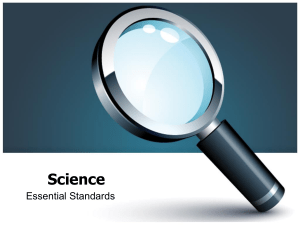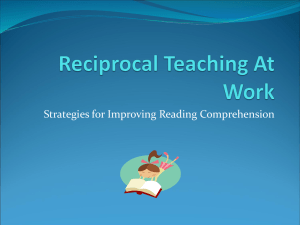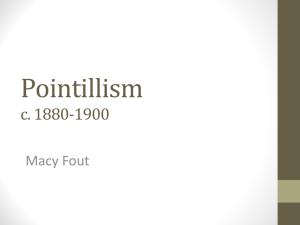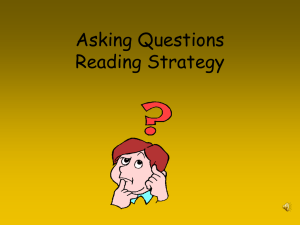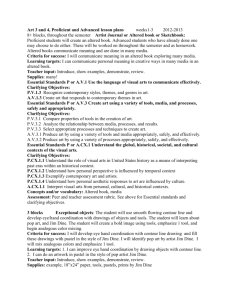wks 15-18
advertisement
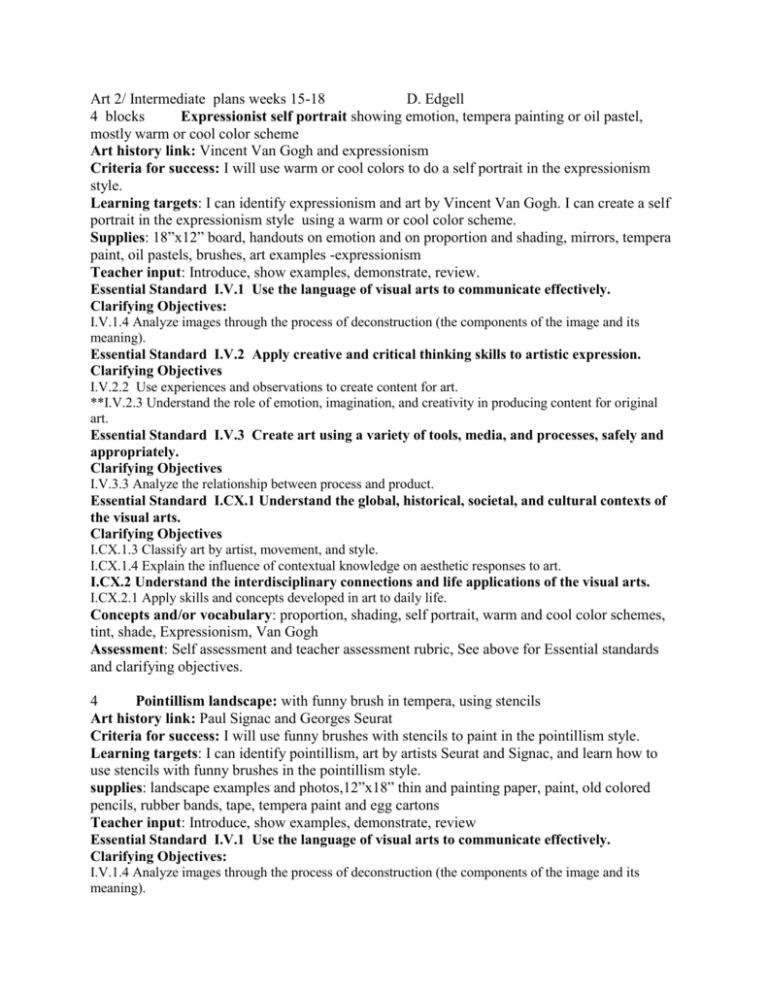
Art 2/ Intermediate plans weeks 15-18 D. Edgell 4 blocks Expressionist self portrait showing emotion, tempera painting or oil pastel, mostly warm or cool color scheme Art history link: Vincent Van Gogh and expressionism Criteria for success: I will use warm or cool colors to do a self portrait in the expressionism style. Learning targets: I can identify expressionism and art by Vincent Van Gogh. I can create a self portrait in the expressionism style using a warm or cool color scheme. Supplies: 18”x12” board, handouts on emotion and on proportion and shading, mirrors, tempera paint, oil pastels, brushes, art examples -expressionism Teacher input: Introduce, show examples, demonstrate, review. Essential Standard I.V.1 Use the language of visual arts to communicate effectively. Clarifying Objectives: I.V.1.4 Analyze images through the process of deconstruction (the components of the image and its meaning). Essential Standard I.V.2 Apply creative and critical thinking skills to artistic expression. Clarifying Objectives I.V.2.2 Use experiences and observations to create content for art. **I.V.2.3 Understand the role of emotion, imagination, and creativity in producing content for original art. Essential Standard I.V.3 Create art using a variety of tools, media, and processes, safely and appropriately. Clarifying Objectives I.V.3.3 Analyze the relationship between process and product. Essential Standard I.CX.1 Understand the global, historical, societal, and cultural contexts of the visual arts. Clarifying Objectives I.CX.1.3 Classify art by artist, movement, and style. I.CX.1.4 Explain the influence of contextual knowledge on aesthetic responses to art. I.CX.2 Understand the interdisciplinary connections and life applications of the visual arts. I.CX.2.1 Apply skills and concepts developed in art to daily life. Concepts and/or vocabulary: proportion, shading, self portrait, warm and cool color schemes, tint, shade, Expressionism, Van Gogh Assessment: Self assessment and teacher assessment rubric, See above for Essential standards and clarifying objectives. 4 Pointillism landscape: with funny brush in tempera, using stencils Art history link: Paul Signac and Georges Seurat Criteria for success: I will use funny brushes with stencils to paint in the pointillism style. Learning targets: I can identify pointillism, art by artists Seurat and Signac, and learn how to use stencils with funny brushes in the pointillism style. supplies: landscape examples and photos,12”x18” thin and painting paper, paint, old colored pencils, rubber bands, tape, tempera paint and egg cartons Teacher input: Introduce, show examples, demonstrate, review Essential Standard I.V.1 Use the language of visual arts to communicate effectively. Clarifying Objectives: I.V.1.4 Analyze images through the process of deconstruction (the components of the image and its meaning). Essential Standard I.V.2 Apply creative and critical thinking skills to artistic expression. Clarifying Objectives I.V.2.2 Use experiences and observations to create content for art. Essential Standard I.V.3 Create art using a variety of tools, media, and processes, safely and appropriately. Clarifying Objectives I.V.3.3 Analyze the relationship between process and product. Essential Standard I.CX.1 Understand the global, historical, societal, and cultural contexts of the visual arts. Clarifying Objectives I.CX.1.3 Classify art by artist, movement, and style. I.CX.1.4 Explain the influence of contextual knowledge on aesthetic responses to art. Concepts and/or vocabulary: foreground, middleground, background, atmospheric perspective, stencil, pointillism, Seurat, Signac, analogous and complementary colors Assessment: Self assessment and teacher assessment rubric, See above for Essential standards and clarifying objectives. 3-5 Koi and landscape watercolors : Students will use various watercolor techniques including wet-into-wet, plastic wrap, wash. Landscape painted from foreground to background. Art history link: Oriental art Criteria for success: I will use various watercolor techniques to create paintings in the Oriental tradition. Learning targets: I can use some of these watercolor techniques: wet-into-wet, wash, wet on dry, dry brush, shaded edges, spattering, plastic wrap in a painting. Supplies: heavy paper, tube watercolors, plastic trash bags (cut), palettes, brushes Teacher input: Introduce, show examples, demonstrate, review Essential Standard I.V.1 Use the language of visual arts to communicate effectively. Clarifying Objectives: I.V.1.3 Understand the use of global themes, symbols, and subject matter in art. Essential Standard I.V.2 Apply creative and critical thinking skills to artistic expression. Clarifying Objectives I.V.2.1 Generate innovative solutions to artistic problems. I.V.2.2 Use experiences and observations to create content for art. I.V.2.3 Understand the role of emotion, imagination, and creativity in producing content for original art. Essential Standard I.V.3 Create art using a variety of tools, media, and processes, safely and appropriately. Clarifying Objectives I.V.3.1 Understand the function of tools in creating art. I.V.3.3 Analyze the relationship between process and product. Concepts and/or vocabulary: unity, rhythm, movement, wet-into-wet, wash, wet on dry, dry brush, masking, foreground, middleground, background, atmospheric perspective Assessment: Self assessment and teacher assessment rubric. See above for Essential standards and clarifying objectives.
